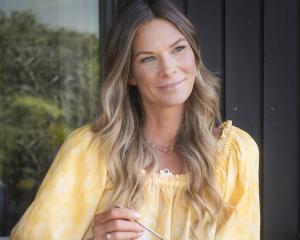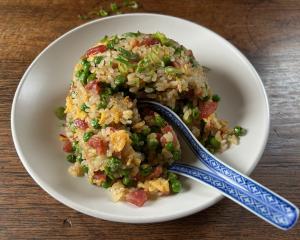Chardonnay is like vanilla or chocolate - it goes in and out of fashion, master of wine Michael Brajkovich says.
"And wine is a fashion thing.''
Brajkovich's family run Kumeu River, a vineyard 20km northwest of Auckland, which was established in 1944 by Michael's grandparents Mick and Kate Brajkovich.
His father, who was a prominent figure in the New Zealand wine community, died in the 1990s and his mother, he and his three siblings now run the vineyard.
The winery specialises in chardonnay, a wine variety that has been overtaken in the past few years in the public's mind by the sauvignon blanc success story. Of all wine produced in New Zealand, only 9% is chardonnay, compared with 71% sauvignon blanc.
However, the variety's "bad image'' did not show up in Kumeu's sales figures as it was at the top end of the chardonnay market, Brajkovich said while in Dunedin last week.
"We did dabble in sauvignon blanc years ago but decided it's a weed and best grown in Marlborough so we no longer participate in that. But clearly savignon blanc is a very important part of New Zealand's wine picture.''
It was "pretty evident early on'' that chardonnay was the family's best variety and it now accounted for 75% of the winery's production. The rest are pinot gris and pinot noir.
Also, Brajkovich firmly believes chardonnay is the best wine grape variety in the world as it can produce a wide range of styles - very crisp and clean chablis and sparkling styles right through to much heavier, richer, more developed, oak-aged styles in different climates.
It has been planted in every wine-growing region in New Zealand, including Otago.
"Wherever you go in New Zealand, you are in a cool climate. Even though we are in an area up north, it is still cool. The ocean influence moderates our climate, retaining acidity, and allows us to make cool-climate wines.''
There was a resurgence of interest worldwide in chardonnay, but particularly in New Zealand and Australia, he said.
"There are some really great things happening. The wine is not necessarily more austere or restrained.''
The variety had changed as the styles became more sophisticated. The "big, yellowy, oaky, buttery, alcoholic, all those things which are quite tiring for drinking wine'' were not so popular.
The first duty of a white wine was to be refreshing, so that was the aim of Kumeu, which got its inspiration from the classic white Burgundy of France.
"They make the best dry white wines in the world.''
A pivotal moment for Kumeu came a year ago when highly regarded wine merchant Farr Vintners in London held a blind tasting of its wines alongside a selection of French white Burgundy.
A bottle of each of Kumeu's four chardonnays - Estate 2012, Coddington 2010, Mate's 2009 and Hunting Hill 2007 - went up against a range of premier cru and village Burgundies from the best producers - Leflaive, Lafon, Sauzet and Niellon - from the same vintages.
"All we want to do is to be considered on the same page, of similar quality. We represent really good value in comparison.''
A panel of experts and wine writers judged the wines - Jancis Robinson Master of Wine (MW), Derek Smedley MW, Neal Martin (The Wine Advocate), Mattew Jukes (Daily Mail), Tina Gellie (Decanter magazine), Jamie Goode (Wineanorak.com) and Will Lyons (Wall Street Journal).
"Three came out on top and one first-equal. It was a real boost for us.''
After that tasting and the resulting publicity, sales increased.
"We've had a great year, particularly in the UK but it has also spilled over to other markets.''
For Brajkovich and his family it was "hugely gratifying'' to get that result.
"We've been aware for a long time our wines are very good. But to get that kind of recognition from people you respect is fantastic.''
It confirmed that New Zealand wineries "punched above their weight'' and their willingness to innovate and change quickly and make significant improvements resulted in great wine.
"We are not hampered by historical baggage but a lot of the old world producers are.''
An example of this was New Zealand's use screw caps. Kumeu was one of the first New Zealand wineries to do so, in 2001.
In the tasting, Kumeu wines were the only ones closed by cap, which Brajkovich believes made a huge difference to the crispness and appeal of the wines.
"It's one of the reasons we did so well.''
It was a call made after Kumeu had problems with corks. As cork is a natural product it is extremely variable and the risk of taint was a big issue in the 1990s.
On background knowledge Brajkovich had of tasting Australian capped wines and studying it at Roseworthy College in Australia during his oenology (wine science) degree, they decided to cap their wines.
"Wines sealed for 10 or 15 years looked fantastic, not preserved in time but allowed to develop. I thought if we could get that kind of age at 10 years then that's what we wanted.
"We've not looked back. It's been fantastic for us.''
He was surprised "old world'' wineries had not picked up using caps in any major way.
"They are tied to their own history and what perceptions of quality are about.''
The increasing success of Kumeu's wines meant an increase in demand, which the winery struggled to meet. The United Kingdom is its biggest market and in the United States the market is rebuilding after the global economic crisis.
"A good problem to have, but a problem nonetheless. We have to get a little bit bigger but not too so.''
They have purchased grapes from Hawke's Bay and are looking to buy some good wine land there as well, to help meet the demand.
The increasing urbanisation of Auckland and rising land prices mean expanding at Kumeu is not affordable.
"Kumeu is under severe threat of urbanisation.''
While the new Auckland unitary plan has Kumeu outside the rural-urban boundary, to his relief, the pressure on housing and the Government's recently released national policy statement to free up land, means Kumeu is under increasing threat, he says.
"Lots of people in our district would love to subdivide but I don't think it is a good idea for the future of Auckland to have open slather. It's going to be dreadful.''
The family is keen to stay where it is but the lack of affordable land means it has to look elsewhere if it is going to keep up with demand.
"We'll still be focusing very much on chardonnay. It's what we know.''
That does not mean they are not experimenting. A new sparkling wine is due to hit the market by the end of the year. Only a few thousand bottles a year are to be produced.
"So far it looks really good.''
It is something he has been thinking about for a long time, reinforced by best-selling wine writer Hugh Johnson, who, after tasting his chardonnay in New York, asked if he had thought about making "bubbles''.
"If he thought this chardonnay could make a sparkling then maybe it was time to experiment.''
With help from others in the industry, in particular Quartz Reef winemaker Rudi Bauer, he had gone on to produce the new wine - a blend of chardonnay and pinot noir grapes - harvested a bit earlier than normal.
His experience judging wine for the past 30 years - he is the chairman of judges for the Air New Zealand Wine Awards and for the the Adelaide Wine Show - meant he had seen "incredible progress'' and stylistic changes, to culminate in New Zealand wines being some of the best in the world.
"It's staggering how far we have come in such a short period of time.''
Pinot noir really is the outstanding grape variety, he says. Clearly New Zealand does very well with sauvignon blanc, as well. Sparklings are on the up and up and chardonnays are a star performer in all areas.
Smaller varieties such as pinot gris and the difficult-to-sell rieslings and "fantastic'' gewurztraminer were improving but struggling to sell, he said.
Working alongside his mother Melba, brothers Milan and Paul and sister Marijana was a success, he said.
"We all get on and have our own area of expertise.''
It also helped that the family could share the travelling required by the job to promote their wines.
As for whether the fourth generation will soon be joining the family business, only time will tell. The nine great-grandchildren ranged in age from 12 to 24 so there was plenty of time, he said.












